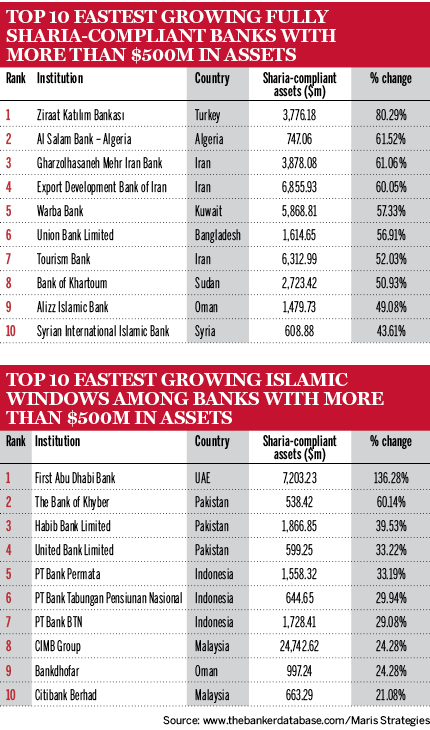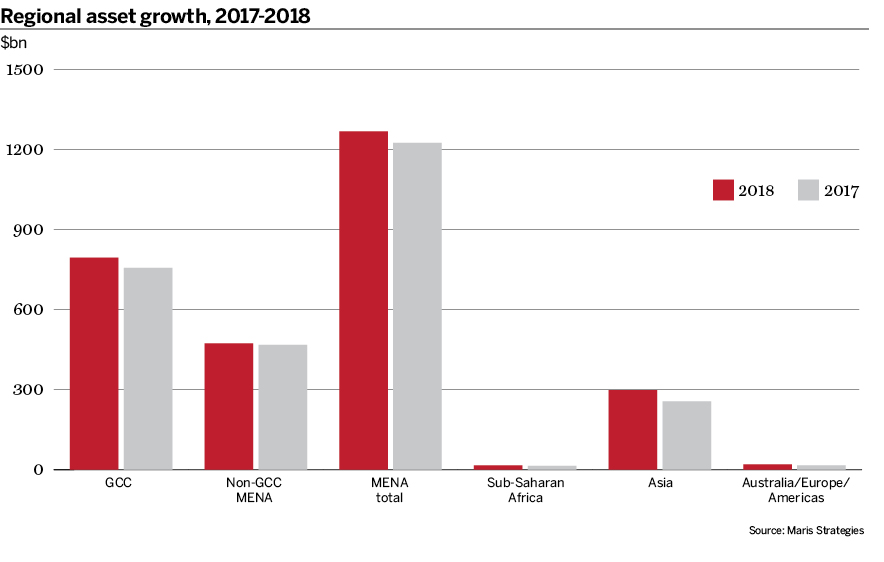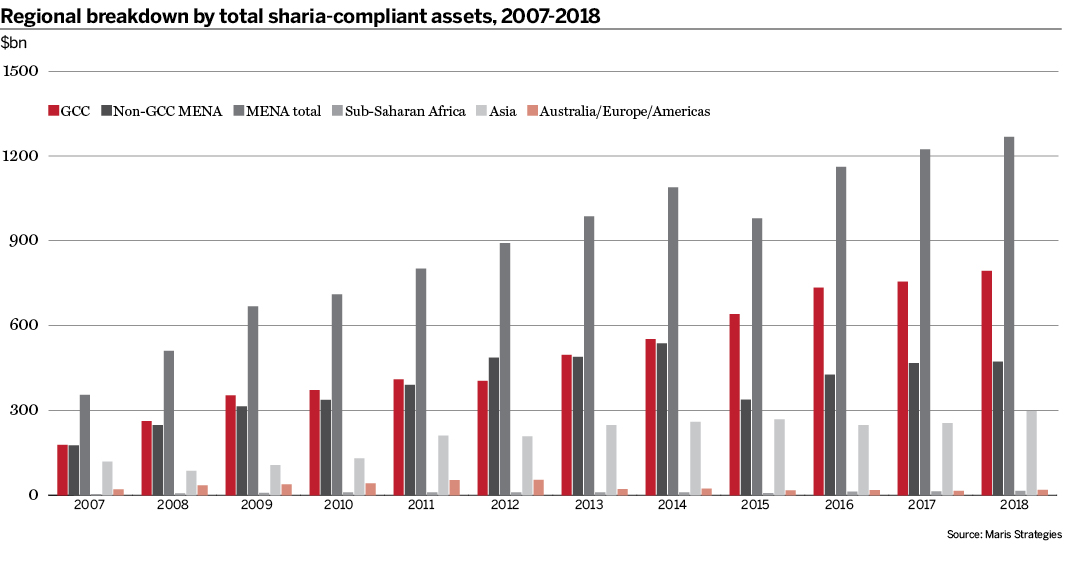The Banker's Top Islamic Financial Institutions – 2018
The Banker's 2018 Top Islamic Financial Institutions ranking shows that Islamic banks are doing well, especially in frontier states, with GCC dominance being challenged by previously underserved markets in Africa and Asia. James King reports.
The Banker’s 2018 Top Islamic Financial Institutions ranking offers a snapshot of an industry that has shrugged off the challenges of the recent past and is rebounding at a steady pace. Building on the strong results posted in the 2017 ranking, this year’s edition reveals exceptional asset growth across every region, coupled with a growing number of new institutions that are springing up in less developed markets.
These trends, and others, point to the industry’s advancing frontier and the long-term growth prospects on offer in regions such as sub-Saharan Africa and south Asia, which remain relatively untapped.
Sharia assets up
Globally, total sharia assets increased by 7.59% over the review period, reaching $1624bn. This is a notable increase from the 4.74% growth recorded in the 2017 edition. But unlike last year’s ranking, there has been a notable shift in the source of this asset growth. Asset expansion in Australia, Europe and the US, taken together, hit 20.2%, while Asia and sub-Saharan Africa registered growth of 16.3% and 12.6%, respectively. Meanwhile, the states of the Gulf Co-operation Council (GCC) and the rest of the Middle East and north Africa, excluding the GCC, saw their total assets increase by 5% and 6.3%, respectively.
The relative decline of GCC institutions in the asset growth stakes is a trend that has been identified in previous Top Islamic Financial Institutions rankings. This year, it is more notable. Of the 10 fastest growing fully sharia-compliant institutions with assets of more than $500m, only two banks hail from the Gulf. Meanwhile, it is a similar story for the 10 fastest growing windows, with only two GCC institutions making the cut. One of these is a new arrival: First Abu Dhabi Bank (FAB) which tops the list. Nevertheless, if the GCC is considered on a standalone basis, it still offers a solid suite of performance metrics.
Beyond asset growth, the 2018 ranking deviates from the trend of growing profitability in recent years with average return on assets falling to 1.21%. Though it is a marginal decrease from the 1.29% recorded in 2017’s edition, it is nevertheless the first time that profitability has slumped in recent times. This can partly be explained by the rate of asset growth in the 2018 ranking, which at 7.58% is close to double that experienced in the previous ranking. But it also mirrors the ongoing maturation of key markets in the GCC at a time when some governments are scaling back their spending, as well as the growing number of smaller institutions that are featured in this year’s edition.
African entries
The number of Islamic financial institutions with less than $100m in assets has increased to 102 in the 2018 ranking, up from 91 last year. Among other trends, this points to the growth of new institutions in some of the industry’s more frontier markets. Indeed, for the first time in the history of The Banker’s Top Islamic Financial Institutions ranking, entities from the Gambia and Senegal have been included.
This comes as the west Africa region is starting to take serious strides towards the development of a sharia-compliant marketplace. In September 2017, Nigeria’s Debt Management Office issued a N100bn ($277m) debut sukuk through a locally incorporated special purpose vehicle. This followed a debut issuance by Senegal in 2014 and Côte d'Ivoire in 2015. Togo and the Gambia have also issued sovereign sukuk. With a majority Muslim population and the highest birth rates in the world, according to UN data, west Africa could become a meaningful centre of Islamic finance in the coming years.
Meanwhile, new lenders have also been included from jurisdictions such as Kazakhstan, adding weight to the country’s total contributions to the ranking. The large and underserved populations in frontier markets represent the future of the industry, and in the 2018 ranking this growth story has been made clear. The fastest growing sharia-compliant windows with assets of more than $500m, for example, largely hail from Indonesia and Pakistan.
Rising Asian markets
Both countries preside over relatively embryonic Islamic finance sectors but both are pushing hard to develop sharia-compliant financial services within their borders. In 2017, Pakistan as a whole saw its total number of Islamic assets jump by 22%, while total deposits grew by 19.8%, according to research from the State Bank of Pakistan. The market share of Islamic banking assets stood at 12.4% at the end of 2017.
In Indonesia, there is even more work to do. According to the country’s financial regulator, total Islamic banking assets account for about 6% of the system’s total. Nevertheless, Islamic asset growth hit 19% in 2017 compared with about 7% for conventional banks. The strong figures for both countries are evident in the ranking; Pakistani windows account for positions two, three and four among the top 10 fastest growing windows. Positions five, six and seven are filled by Indonesian institutions.
Nevertheless, neither country boasts a lender among the leading institutions by either pre-tax profits or return on assets. With time, regulatory improvements and a maturation of services, this is likely to change. But for now three of the GCC region’s big-hitting Islamic lenders have, once again, dominated in the profitability stakes, even as the regional market as a whole continues to mature. Saudi Arabia’s Al Rajhi Bank, the world’s largest Islamic lender, has once again reaped the benefits of its multi-year transformation strategy by securing top spot in terms of total pre-tax profits ($2.43bn) while also coming in at number four in terms of its return on assets (2.77%).
Dubai Islamic Bank, meanwhile, saw return on assets (ROA) hit 2.37%, while pre-tax profits grew by more than 11% to reach $1.23bn over the review period. Another Emirati lender, Abu Dhabi Islamic Bank, rounds out the best performing Gulf banks by profitability with net profits jumping 18.6% as its ROA came in at 1.92%, well above the ranking-wide average of 1.21%. Beyond the Gulf, Egypt’s Faisal Islamic Bank and Sudan’s the Blue Nile Mashreq Bank are the two other lenders to be among the leading institutions by both their pre-tax profit growth and ROA.
Turkish delight
In terms of asset growth, the 10 fastest growing fully sharia-compliant institutions (with assets greater than $500m) in this year’s ranking comprise a more diverse range than in 2017. Topping the list is Turkey’s Ziraat Katilim Bankasi, which saw its assets grow by just over 80%. This is a very strong performance, easily outpacing the average asset growth of 21% recorded for Islamic banks in the country in 2017. Even so, the assets of Turkey’s Islamic banks remain low, at just under 5% of the banking system’s total by the end of 2017, according to data from the Participation Banks Association of Turkey. Ziraat Katilim’s Islamic banking market share was about 9% in the fourth quarter of 2017, according to the same source.
Taking second spot is Algeria’s Al Salam Bank, the in-country unit of the Bahraini lender of the same name. Its sharia-compliant assets grew by 61.5% to hit $747m. It comes as Algeria’s authorities are pushing hard to develop the country’s Islamic finance market. As the economy endures several pressures – the most challenging of which is a drop in energy revenues – the government hopes to tap into the informal economy and attract new sources of funding through sharia-compliant channels.
Achieving this will be difficult. Algeria is well behind its Maghreb peers in terms of its regulatory and legal structures for Islamic finance. It also lacks the depth and breadth of sharia-compliant expertise.
Nevertheless, a number of Algeria’s state-owned banks have announced plans to offer Islamic products and services. And reports from international media sources indicate that the government is mulling the creation of a sharia board to oversee the industry. In light of these developments, Algerian institutions could become a feature of the fastest growing sharia-compliant banks list in the years ahead.
Repeat success
Meanwhile, two lenders make a repeat appearance in the table. Oman’s Alizz Islamic Bank, which comes in at ninth position and enjoyed asset growth of 49%, was at number eight in the 2017 edition. This performance partly reflects Bank Al Izz’s relative youth; founded in November 2012, it has been growing at a considerable pace by tapping into the Oman’s unmet demand for Islamic financial services and products.
Moving forward, Alizz Islamic Bank is holding discussions with Oman Arab Bank to execute a merger. This would create an entity with about $7.6bn in assets (according to research from Moody’s) and significantly bolster the combined institution’s ability to compete both domestically and regionally.
The second bank to make the table for the second time this year is Syrian International Islamic Bank, which comes in in 10th spot with 43% growth in assets, compared with a 53% growth in its assets in the 2017 edition. This bodes well for the lender, which has endured a mix of conflict and sanctions over recent years.
The other big takeaway from the 2018 ranking comes at the very top of the main ranking. Here, Kuwait Finance House (KFH) has made a sizeable leap up over the overall standings to scoop third position with asset growth of 8.71% in 2017. KFH’s total assets stood at $57.86bn at the end of the year. The size of this asset base could grow substantially, however, as discussions over a potential merger continue between KFH and fellow Islamic lender Ahli United Bank of Bahrain. Data from Thomson Reuters indicates that, if a merger were executed, the combined assets of the new entity would be about $90bn, putting it within touching distance of the top spot in The Banker’s ranking.
For now, KFH’s rise up the rankings comes at the expense of Saudi Arabia’s National Commercial Bank (NCB). In the 2018 edition, NCB sits at number four in the main ranking, down from second place in the 2017 edition. This comes as the Saudi lender saw only marginal asset growth of 0.83%. Nevertheless, as NCB continues on its journey to becoming fully sharia compliant, the percentage of its Islamic assets edged up slightly to reach 47.78% from 47.32% over the review period.
A positive picture
The Banker’s 2018 Top Islamic Financial Institutions ranking clearly points to an industry that is in good health. Strong asset growth and generally solid (if unspectacular) profitability is going hand in hand with the expansion of sharia-compliant services into less developed markets. Taken together, this bodes well for the industry’s growth in the coming years. As new players such as Senegal and Côte d'Ivoire tap the sukuk market, and markets such as Algeria begin to open up their financial services sector to a wider array of sharia-compliant products and services, there is ample room for growth to pick up in these markets.
As this happens, developments in the more established markets of the GCC are leading towards market consolidation. For the industry as a whole, this is a good thing. As growth opportunities across the Gulf remain less abundant than they once were, regional banks are turning towards mergers and acquisitions to boost their competitive edge. In turn, this is producing large domestic and regional entities that can compete with the biggest conventional players. Over time, this trend should lead to Islamic banks playing an increased role in the largest and most sophisticated transactions, at both a regional and global level.






